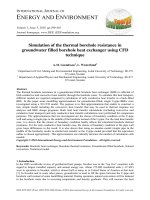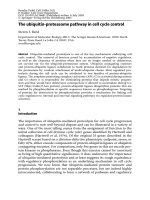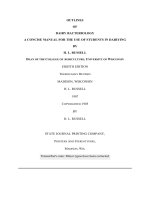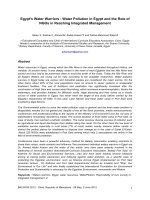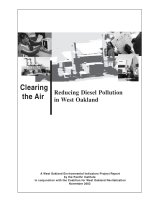LEBANESE AMBER The Oldest Insect Ecosystem in Fossilized Resin pptx
Bạn đang xem bản rút gọn của tài liệu. Xem và tải ngay bản đầy đủ của tài liệu tại đây (1.73 MB, 97 trang )
One of the earth’s oldest natural treasures,
Lebanese amber unlocks the secrets of
a little-known world populated by dinosaurs,
p t e ro s a u rs , and cycads. Dating back some
135 million years to the early Cretaceous,the
amber contains the earliest known re p re s e n t a t ives of many insect gro u p s . It wa s
f o rmed in a we t ,t ropical kauri pine forest long before Earth’s continents reached
their present positions.
This extensively illustrated book, the first major review of Lebanese amber, covers
all aspects of this rare and highly valued resin,including its origin and its role as a
commodity in ancient cultures.The authors discuss each plant and animal fossil
thus far recovered from the amber, including nematodes,snails, mites,spiders and
insects,and the earliest complete feather.
Pa l e o n t o l ogi s t s , b i o l ogi s t s , and evolutionists will appreciate the book’s new
i n f o rm a t i o n , along with its summary of early research and its analysis of how
these amber fossils can increase our understanding of insect dive rs i f i c a t i o n ,
b i og e ogr a p hy, e x t i n c t i o n , and surv i va l .With its descriptions of the ori gi n s ,
c h a r a c t e ri s t i c s , and ancient uses of Lebanese amber and other Near Eastern re s i n s ,
the book will appeal to readers of natural history and amber and gem collectors
as well.
In the hands of George Poinar and Raif Milki, who have long shared a passion for
these little-investigated deposits, Lebanese Amber presents a powerful,exquisitely
detailed portrait of an ecosystem that, without them, might have remained lost to
us forever.
g e o rge poinar, j r. is an authority on amber and the author or co-author of
numerous books, including The Amber Forest,Life in Amber, and The Quest for Life in
Amber. Formerly a faculty member in the Department of Entomological Sciences
at University of California, Berkeley, he joined the Oregon State University
Department of Entomology in 1995.
Lebanese Amber
The Oldest Insect Ecosystem in Fossilized Resin
George O. Poinar, Jr. and Raif Milki
OSU
P re s s
raif milki, the foremost expert on Lebanese
amber, is a professor of Public Health at the
American University of Beirut.
Oregon State University Press ISBN 0-87071-533-X
,!7IA8H0-hbfdde!
LEBANESE AMBER
LEBANESE AMBER
The Oldest Insect Ecosystem in Fossilized Resin
George O. Poinar, Jr.
Raif K. Milki
Oregon State University Press
Corvallis
Publication of this book was made possible by
a contribution from the
Safadi Foundation
The Oregon State University Press is grateful for this support
Front cover photograph of a dance fly close to the genus Brachystoma in the subfamily
Brachystomatinae (Empididae: Diptera) by George O. Poinar, Jr.
Back cover photograph of Dr. Milki collecting amber from 135 million year old Lower
Cretaceous beds on the slopes of Mt. Lebanon by Nesrine Milki
The paper in this book meets the guidelines for permanence and
durability of the Committee on Production Guidelines for Book
Longevity of the Council on Library Resources and the minimum
requirements of the American National Standard for Permanence of
Paper for Printed Library Materials Z39.48-1984.
Library of Congress Cataloging-in-Publication Data
Poinar, George O.
Lebanese amber : the oldest insect ecosystem in fossilized resin /
George O. Poinar, Jr., and Raif Milki 1st ed.
p. cm.
Includes bibliographical references and index.
ISBN 0-87071-533-X (alk. paper)
1. Amber Lebanon. 2. Amber fossils Lebanon. I. Milki, Raif.
II. Title.
QE391.A5 P65 2001
560'.95692 dc21
2001003008
© 2001 George O. Poinar Jr. and Raif Milki
All rights reserved. First edition 2001
Printed in the United States of America
Oregon State University Press
101 Waldo Hall
Corvallis OR 97331-6407
541-737-3166 • fax 541-737-3170
/>Dedication
We dedicate this book to Mohammed Safadi,
who made its publication possible through a contribution
from the Safadi Foundation, which promotes higher
education, technology and research.
CONTENTS
Foreword 9
Preface 10
Scientific aspects of Lebanese amber 12
Introduction 12
Geological Setting 13
Age of Lebanese Amber 15
The Study of Lebanese Amber 15
Plant Source 16
Nature of the Cretaceous Kauri Forest 21
The Shifting Face of Lebanon 26
Types of inclusions in Lebanese Amber 28
Monera 28
Fungi 28
Plantae 31
Animalia 32
Nematoda 32
Mollusca 33
Myriapoda 33
Arachnida 33
Hexapoda 34
Collembola 34
Archeognatha 35
Odonata 35
Ephemeroptera 35
Blattaria 36
Orthoptera 36
Isoptera 37
Psocoptera 37
Hemiptera 37
Neuroptera 40
Coleoptera 41
Thysanoptera 44
Trichoptera 44
Lepidoptera 45
Diptera 45
Hymenoptera 60
Vertebrata 63
Discussion 64
Symbiotic Associations 63
Insect Diversification and Distribution 64
Extinctions: Generic Lineages 66
Insect-plant Associations 70
Insect Population Structure Over Time 71
Comparison of Amber Taxa with Lebanese Fish Fossils 73
Cultural aspects of Lebanese amber 76
The Early History of Lebanese Amber 76
Collecting Lebanese Amber 78
Other Resins, Copals and Gums from Lebanon and the
Near East 79
Acknowledgments 84
References 85
Appendix: Description of Agathis levantensis sp. n. 91
Index 93
Tables
1. Evidence of extinct kauri pines (Agathis spp.) in the northern
hemisphere based on resin analysis 18
2. Geographical location of extant kauri pines (Agathis spp.) 20
3. Genera, families and orders of insects described from
Lebanese amber 29
4. Lebanese amber insect genera reported from other
amber deposits 65
5. Characteristics of extant insect genera in Lebanese amber 66
6. Comparison of common arthropod orders in amber
from Lebanon, Canada (Alberta), and the Dominican
Republic 71
7. Genera (all extinct) of fish fossils from Upper Cretaceous,
Lebanon, with family and ordinal status 74
8. Plant resins, copals, and gums of the past and present
from the Near East that could be confused with
Lebanese amber 81
9
FOREWORD
Some one hundred and thirty million years ago, when dinosaurs
roamed the earth, towering kauri pines in prehistoric Lebanon wept
copious amounts of resin. The resin, which trapped a diverse range of
life, especially insects, eventually transformed into what is known today
as Lebanese amber. This is the oldest known amber to preserve insect
remains and possibly also contains the earliest angiosperm leaves.
Entombed biting insects may even contain the blood of dinosaurs.
Amber is known for preserving fossils in life-like condition, because
they were not subjected to the compression that all too commonly affects
most soft-bodied organisms that enter the prehistoric record. Inclusions
in amber are three dimensional and appear ready to spring out of their
golden tombs and continue their former lives.
Here, for both the professional and amateur, is a well-illustrated
account of Lebanese amber from the Early Cretaceous. Included are
records of the first known appearances of many insect groups, all from
that significant geological interval that so altered the terrestrial world—
the beginning of the flowering plants.
In this first book on amber from Lebanon, the authors include
information from prior descriptions of individual fossils and add a
wealth of new material documented by photographs. They also provide
background information on the geology and occurrence of Lebanese
amber and a comprehensive section on other types of resins and gums
found in the Near East that might be confused with true amber.
Emphasis is placed on co-evolutionary relationships found in Lebanese
amber, some of which persist to the present day. It is a pleasure to read
this work and view the color plates beautifully depicting the most
ancient insects from any amber source.
Dr. Arthur Boucot, Department of Zoology,
Oregon State University
10
PREFACE
The present work is a review of all the organisms thus far reported
from Lebanese amber. Various paleoentomologists have contributed
to the study of Lebanese amber insects. Studies by Paul Whalley, once
at the British Museum, have been especially useful. However, works
like ours are also made possible by those who go into the field and
search for amber sites. Scientists are indebted to these individuals since,
without their zeal, there would not be many scientific descriptions of
amber fossils or books like the present one.
While there are a few collections of Lebanese amber in public
institutions and museums (most of which are inaccessible to viewing),
the majority of this rare fossilized resin resides in private collections.
The fossils depicted in the photographs presented here were collected
by Raif Milki on numerous trips into the field dating back to 1962.
These rare inclusions comprise the Milki Lebanese amber collection
maintained at the American University of Beirut in Lebanon.
Figure 1. Reconstruction of the Early Cretaceous Lebanese amber forest. Plants
include leaves of Agathis levantensis with one male and two immature female
cones in the upper center, leaves of the tree fern Weichselia in the lower right
and a Zamites cycadophyte in the lower left. Dinosaurs include (from left to
right) the head of the large carnivore Carcharodontosaurus; the herbivore
Ouranosaurus with its skin sail; the swift predator Elaphrosaurus in the
foreground; and the large sauropod Dicraeosaurus in the background. A
pterosaur, Pterodactylus, glides overhead and a small triconodont mammal
cowers in the left foreground. A biting midge of the genus Protoculicoides is
entrapped in resin on the bark of the kauri tree in the upper left. (Drawing by
G. Poinar)
11
Lebanese Amber
12
SCIENTIFIC ASPECTS OF LEBANESE AMBER
Introduction
Amber is one of the great natural treasures of Lebanon. The scientific
importance of Lebanese amber lies in its great age. This amber dates
back to the Early Cretaceous and contains the oldest known arthropods
of any fossilized resin deposit. These now extinct organisms lived in a
forest different from any in existence today, long before the land known
as Lebanon reached the Mediterranean Sea. The resin-producing woods
originated in the southern hemisphere when Lebanon was part of the
great continent of Gondwanaland (Figure 2).
Lebanese amber was formed in a tropical-subtropical forest
consisting predominately of kauri pines, cycads, and ferns and
dominated by reptiles including dinosaurs and pterosaurs (Figure 1).
Figure 2. Arrangement of the continents in the Early Cretaceous when the
Lebanese amber forest existed. Black dot represents region of the Lebanese
amber forest. Af = Africa; Ant = Antarctica; As = Asia; Au = Australia; Eu =
Europe; In = India; N = North Pole; NA = North America; S = South Pole; SA =
South America.
13
Lebanese Amber
This sylvan habitat contained some of the earliest flowering plants
(Angiosperms), which had begun to usurp the dominating gymno-
sperms and spore-bearing plants. Lebanese amber may therefore hold
answers to many questions about the origin of these higher plants.
All of the fossils thus far described from Lebanese amber are extinct
at the species level; most are extinct at the genus level, but the majority
belong to extant families. The present work includes four phyla and
six classes, with insect representatives of fifteen orders, twenty-nine
families, fifty-six genera, and sixty-nine species. The striking cases of
four insect genera from Lebanese amber still extant today represent
the longest generic lineages of any land animals.
The Early Cretaceous amber beds in Lebanon cross over the
boundaries of this small country into neighboring areas. This is why
these deposits are sometimes known as “Middle East,” “Near East,” or
“Levantine” amber. However, since the vast majority of fossiliferous
material so far collected and studied has come from Lebanon, the
deposits are most frequently referred to as Lebanese amber.
Geological Setting
The present geographical position of Lebanon has changed from its
location some 150 million years ago, when this area was part of the
supercontinent Gondwanaland (Figure 2). Lebanon then was part of
the Arabian Peninsula attached to the eastern portion of the African
continent and situated on the equator. Africa was still connected to
South America as part of Gondwanaland. India and Madagascar were
united in the southern hemisphere and had only recently separated
from the landmasses of Antarctica, Australia, and New Zealand.
The period of approximately 150 to100 million years ago was one
of uplift and volcanic activity, eventually followed by erosion which
resulted in the formation of rivers, swamps and deltas. At that time ,
the region that we now know as Lebanon was a deltaic plain that
alternately rose above and fell below sea level, thus accumulating large
amounts of marine limestone. Remnants of these deposits occur in the
gorges of northern Mount Lebanon and in the mountain ranges of
Barouk and Hermon. It was during this era that the resiniferous forests
responsible for Lebanese amber existed. The resin fell from the trees,
hardened, and was washed into low-lying plains that were later covered
by shallow seas. Slowly the amber was deposited in sands and shales
of great thickness.
Lebanese Amber
14
Figure 3. Lebanon (major cities
designated by squares) with
amber localities (designated by
circles) on the western slopes
of Mount Lebanon.
Some 100 to 50 million years ago, long after the amber was formed,
limestones and chalks containing the well-known Lebanese fish fossils
were deposited. Over the past twenty million years, the African
continent, with its attached Arabian Peninsula (including Lebanon),
collided with Eurasia, uplifting the rock layers containing the amber
to form the Lebanese mountains (Smith et. al., 1994). Wearing away of
the wetter western slopes of this range eventually exposed the Early
Cretaceous amber-bearing beds where most of the deposits occur
(Figure 3). Localities range from Jezzine in the south to Bqaa Kafra in
the north. It is quite likely that amber is present on the eastern slopes
of these mountains as well as in the Anti-Lebanon ranges but buried
beneath thick deposits.
15
Lebanese Amber
Age of Lebanese Amber
There have been differing opinions regarding the age of Lebanese
amber, partly due to changes made in assigning dates to the various
stages of the Cretaceous. The last report by Schlee (1990) gave a range
of 130 to 135 million years, which corresponds to a period from the
Barremian to the Hauterivian or beginning of the Valanginian (Harland
et al., 1990). While some amber is found in younger Albian-Aptian beds
(97-124 million years), these are considered secondary deposits (Schlee
and Dietrich, 1970). The previously reported age of 130 to 135 million
years is accepted here.
All indications are that amber was being formed in the neighboring
countries at approximately the same time. Jordanian amber is now
believed to be roughly the same age, considerably older than the Aptian-
Albian age, as previously thought (Shinaq and Bandel, 1998). In
addition, amber from Mount Hermon, the eastern escarpments of the
Naftali Mountains, and other areas south of Lebanon throughout the
Levant is considered Hauterivian-Valanginian in age (Nissenbaum and
Horowitz, 1992). Thus the present evidence suggests that the forest of
resin-bearing trees covered a large portion of the Arabian Peninsula in
the Early Cretaceous. The amber is found in sandstone and limestone
sedimentary layers (Plate 1), as well as in lignitic beds among the
sedimentary layers (Plate 7), most originating from the Grès de Base
Formation in Lebanon (Schlee and Dietrich, 1970)(Poinar, 1992) and
the Kurnub sandstone Formation in Jordan (Shinaq and Bandel, 1998).
The Study of Lebanese Amber
During the millions of years Lebanese amber has been in the earth, the
sedimentary layers containing it have been subjected to various stresses
as a result of earth-moving forces. This, coupled with the regular daily
and seasonal fluctuations in temperature affecting the surface layers,
has modified the color and character of the amber. Thus it is not
surprising that much of this aged material is highly fractured and tends
to fall apart as it is removed from the earth, making collection a tedious
and delicate task (Plate 1). Most of the amber is collected in small pieces
less than a centimeter in diameter, though some pieces are fist sized
and quite durable (Figure 4). It is difficult to clearly see many of the
inclusions in the amber matrix; studying and photographing insect
specimens in Lebanese amber is quite a challenge.
Lebanese Amber
16
There are several ways of preventing further deterioration of the
amber. Perhaps the best method involves embedding the amber pieces
in liquid plastic. The plastic enters the cracks and helps to clarify the
amber as well as protect it from further environmental effects. After
the plastic has hardened, both the plastic and embedded amber can be
polished without fear of fracturing the amber further. Care must be
taken with this method however, since if the liquid plastic makes contact
with the membranous surface of insect wings, it can obscure the fine
venation and mask important taxonomic characteristics.
Lebanese amber varies in color from transparent light orange (Plate
3) to dark brown and even black (Plate 4). Much of the amber is opaque
(Plate 5), sometimes with circular (Plate 6) or longitudinal layers. Some
of the amber may be embedded in highly carbonized strata (Plate 7).
The lighter transparent pieces are most valuable to paleontologists since
the fossils can be observed with fewer obscurities.
Plant Source
Modern analytical methods have been used to identify the Lebanese
amber plant source. One procedure, known as carbon-13 nuclear
magnetic resonance (13 CNMR) spectroscopy (abbreviated here to
NMR), characterizes ambers by matching their spectra with those of
resin from living trees. This method is based on the proven assumption
that, even after millions of years, chemical compounds in fossilized
resin are little modified and can be matched with compounds in resin
from living trees. Using this type of “fingerprinting,” Lebanese amber,
Figure 4. Largest pieces of Lebanese amber yet documented.
17
Lebanese Amber
as well as similarly aged amber from neighboring countries, was
determined to have been produced by coniferous trees of the family
Araucariaceae, in particular members of the genus Agathis (Lambert et
al., 1996). This tree genus, one of three extant genera in the
Araucariaceae and commonly known as kauri pines, is absent from
the northern hemisphere today. However chemical analyses of
Cretaceous and even early Tertiary ambers from different localities,
show how widespread kauri pines were throughout the northern
hemisphere (Table 1). Why these trees exist only in the Australasian
region of the southern hemisphere today (Table 2) is an intriguing
question.
An Agathis source for Lower Cretaceous amber from Jordan and
Lebanon was also reported by Bandel and Vavra (1981), who analyzed
fossilized resin with infrared spectroscopy, mass spectroscopy, and thin
layer chromatography. While these authors mentioned finding some
differences between Lebanese and Jordanian amber, the NMR spectra
of amber from these two sources were identical (Lambert et al., 1996).
Coalified Agathis leaf impressions commonly occur in amber-bearing
sandstones and siltstones of the Kurnub group in the Zerka Valley near
the village of Khirbat es Suweirat in Jordan (Bandel and Haddadin,
1979; Bandel and Vavra, 1981). It is highly likely that these leaves
originated from the trees that produced the Near Eastern amber. A
description of the amber Agathis tree based on these leaves and other
characteristics is presented in the Appendix. This new species, Agathis
levantensis sp. n. is considered the source of the Early Cretaceous amber
of Lebanon and the surrounding territories.
Figure 5. Pair of fossilized leaves of Agathis levantensis from amber bearing
Early Cretaceous sedimentary deposits in the Zerka valley of Jordan.
Lebanese Amber
18
Table 1. Evidence of extinct kauri pines (Agathis spp.) in the northern
hemisphere based on resin analysis
Location Date of Types of analysis Reference
deposit
(mya)
Baltic region 40 Infra red spectrometry, Langenheim, 1969;
(Europe) Chemical analysis Thomas, 1969; Gough
and Mills, 1972
Washington 50 Nuclear magnetic Lambert et al., 1990,
State (USA) resonance 1996
British Columbia 55 Nuclear magentic Poinar et al., 1999
(Canada) resonance
Alberta, 70-80 Infra red spectrometry Langenheim and Beck,
Manitoba 1968
(Canada) Pyrolysis mass Poinar and Haverkamp,
spectrometry 1985
Nuclear magnetic Lambert et al., 1990,
resonance 1996
Kansas (USA) 70-80 Nuclear magnetic Lambert et al., 1996
resonance
Mississippi (USA) 80-90 Nuclear magnetic Lambert et al., 1996
resonance
New Jersey 70-95 Nuclear magnetic Lambert et al., 1990
(USA) resonance
France 90-97 Nuclear magnetic Lambert et al., 1996
resonance
Alaska (USA) 100 Pyrolysis mass Poinar and Haverkamp,
spectrometry 1985
Nuclear magnetic Lambert et al., 1990,
resonance 1996
Greenland 104-112 Nuclear magnetic Lambert et al., 1996
resonance
Lebanon 120-135 Infra red spectrometry Bandel and Vavra,
1981
Nuclear magnetic Lambert et al., 1996
resonance
Jordan 120-135 Infra red spectrometry Bandel and Vavra,
1981
Nuclear magnetic Lambert et al., 1996
resonance
Switzerland 55-200 Nuclear magnetic Lambert et al., 1996
resonance
Bavaria 220-230 Nuclear magnetic Lambert et al., 1996
(Germany) resonance
19
Lebanese Amber
Figure 6. Leaf of Agathis levantensis in Jordanian sedimentary deposits.
Figure 7. Microscopic examination of Agathis levantensis leaves with three
parallel veins and outlines of cell walls.
Figure 8. Cellular inclusions in leaf remains of A. levantensis .
Lebanese Amber
20
Table 2. Geographical location of extant kauri pines (Agathis spp.)
(After Whitmore, 1980 and de Laubenfels, 1988)
Species Locality Biome
A. atropurpurea Hyland Queensland, Australia Tropical rain forest
A. australis (Lambert) New Zealand (North Warm temperate forest
Steud Island)
A. borneensis Warburg Malaysia, Borneo, Tropical rain forest
N. Sumatra
A. celebica (Koord.) Warb. Malaysia, Borneo, Tropical rain forest
N. Sumatra
A. corbassonii de New Caledonia Subtropical rain forest
Laubenfels
A. dammara (Lambert) Philippines, Mollucans, Tropical rain forest
Richard Celebes
A. endertii Meijer Drees Borneo Tropical rain forest
A. flavescens Ridley Malaya Montane forest
A. kinabaluensis de Sabah Upland rain forest
Laubenfels
A. labillardiere Warburg New Guinea, Papua Tropical rain forest
New Guinea
A. lanceolata Lindley ex New Caledonia Subtropical forests
Warburg
A. lenticula de Laubenfels Sabah Montane rain forest
A. macrophylla (Lindley) New Hebridies Tropical rain forest,
Masters subtropical montane
forest
A. microstachya Bailey Australia Lowland tropical rain
and White forest
A. montana de Laubenfels New Caledonia Montane forest
A. moorei (Lindley) Masters New Caledonia Tropical lowland forest
A. orbicula de Laubenfels Sabah, Sarawak Low montane rain forest
A. ovata (Moore) Warburg New Caledonia Lowland rain forest
A. philippinensis Warb. Philippines, Celebes Upland rain forest
A. robusta (Moore) Bailey New Britain, Tropical and subtropical
Papua New Guinea, rain forests
Australia
A. silbai de Laubenfels Espiritu Santo Lowland rain forests
A. spathulata de New Guinea Rain forest
Laubenfels
21
Lebanese Amber
Figure 9. Fossilized female cone scale of A. levantensis in sedimentary rock
layers in the Zerka valley of Jordan.
Nature of the Cretaceous Kauri Forest
The ancient Lebanese amber forest probably shared some aspects with
the present-day kauri woods of New Zealand and Australia, the major
exceptions being that the ancient forest would have contained many
less angiosperms and many more reptiles. Evidence suggests that
marshy areas dotted the amber forest, which extended to the coast in
low-lying deltaic areas (Nissenbaum and Horowitz, 1992). The mature
trees of A. levantensis probably reached gigantic proportions and ranged
from 500 to 1,000 years in age, as does A. australis in New Zealand
(Figure 10) (Poinar and Poinar, 1994). While the male and female cones
are similar to those of other conifers, the flattened broad leaves of kauri
pines are quite different from the needle-shaped leaves of what we
know as pines today (Figure 1, Plate 2).
Other plant fossils in the Early Cretaceous sandstones of the Zerka
Valley, which undoubtedly formed part of the Lebanese kauri forest,
included the tree fern, Weichselia reticulata (Stokes and Webb) and the
cycad Zamites buchianus (Etten.) with nearly parallel-sided pinnae.
Remains of conifers belonging to the genera Mesembrioxylon and
Brachyphyllum have also been reported, but the family affinities of these
is still unclear (Edwards, 1929). Portions of leaves resembling members
of the Ginkgoales were recovered from the same beds as A. levantensis
(Figure 11). These beds also contain pyritized nodules (Figure 12), some
of which represent replaced cycadeen cones (Shinaq and Bandel, 1998).
Dark muriform fossil fungal spores resembling Steganosporium
(Figure 13) and Alternaria (Figure 14) have been recovered from crushed
Lebanese Amber
22
Figure 10. Base of an extant kauri pine,
Agathis australis, in New Zealand.
leaf remains of A. levantensis. Both of these genera of Hyphomycetes
are reported as plant saprophytes or weak parasites today.
What caused the large resin production of these extinct kauri pines
in the Early Cretaceous? Was it a sign of stress resulting from disease
or a climate change or was resin production a natural deterrent for
large herbivores such as plant-eating dinosaurs? Although there are
no published descriptions of dinosaurs from Lebanon, their remains
occur on the Arabian Peninsula (Jacobs, 1993). The ranges of several
genera of these ancient reptiles reported from the Early Cretaceous of
Northern Africa (Weishampel et al., 1990)(Jacobs, 1993) probably
extended into the forests and swamps of the Lebanese amber forest.
These dinosaurs (Figure 1) are not the common ones that we hear
about today in the popular press and films, but may have included the
narrow-headed iguanodontid, Ouranosaurus, a 7-meter-long herbivore.
Recognized by a distinct skin sail that ran along its entire backbone,
this stocky dinosaur presumably reared up on its extended hind legs
to gather, with a prehensile tongue, tender leaves into its beak-like
mouth. Also most likely grazing in the kauri forest was Dicraeosaurus,
a 6-ton sauropod reaching 20 meters in length. These, along with other
still-undiscovered dinosaurs, would have been prey for the 8-meter-
long carnivore, Carcharodontosaurus. With flesh-tearing, shark-like teeth
13 centimeters long, this bipedal so- called shark lizard would have
been a formidable foe for any creature, even a smaller predator like
23
Lebanese Amber
Elaphrosaurus. The latter, a 3.5-meter-long ostrich-like dinosaur with a
long neck, small head, large eyes, and long, narrow, toothless beak,
presumably ran swiftly through the underbrush on its hind legs,
snatching birds and lizards off low tree branches with its three-fingered
hands (Weishampel et al., 1990).
Some of its victims may have been small pterosaurs which were
more abundant than birds at this time (Figure 1). Even snakes, whose
occurrence coincided with that of the Lebanese amber forest, may have
been prey items. Certainly, representatives of the strange reptilian order
known as the Rhynchochephalia were hunted by dinosaurs. If we can
assume that the habits of early members of this group were similar to
those of the tuatara, the sole survivor of this order, living today on off-
shore islands in New Zealand, then the ancient forms, which possessed
Figure 12. Iron pyrite crystals from Jordanian sedimentary deposits containing
A. levantensis leaves.
Figure 11. Fossil Ginko-like leaf occuring in same sedimentary deposits as
A. levantensis.
Lebanese Amber
24
Figure 13. Dark, muriform fossil spore resembling members of the extant genus
Steganosporium (Moniliales) from macerated leaf of Agathis levantensis.
Figure 14. Dark, muriform fossil spore resembling species of the extant genus
Alternaria (Moniliales) from macerated leaf of Agathis levantensis .
Figure 15. Pollen grain of Agathis levantensis from macerated leaf tissue.
